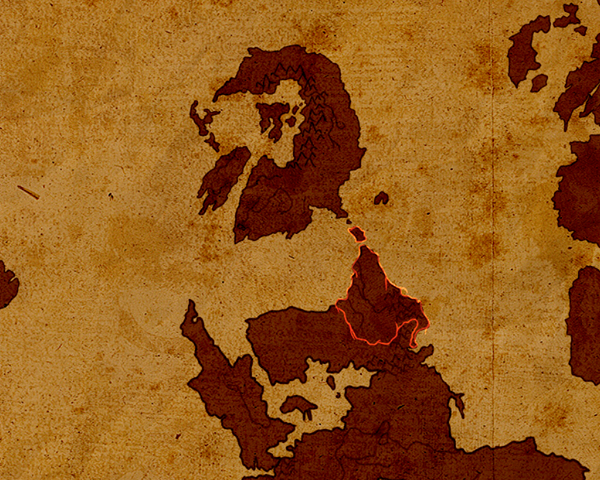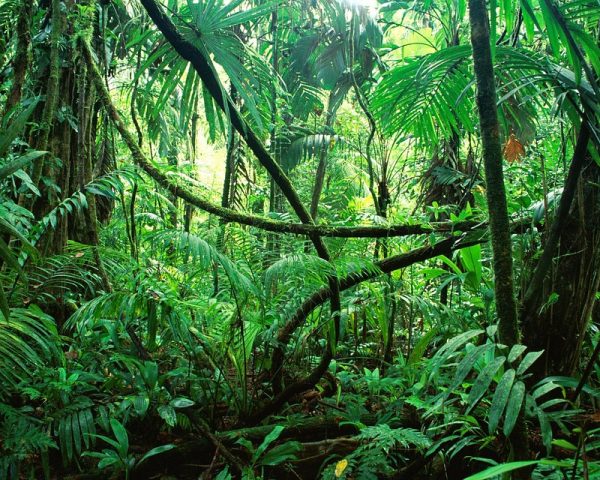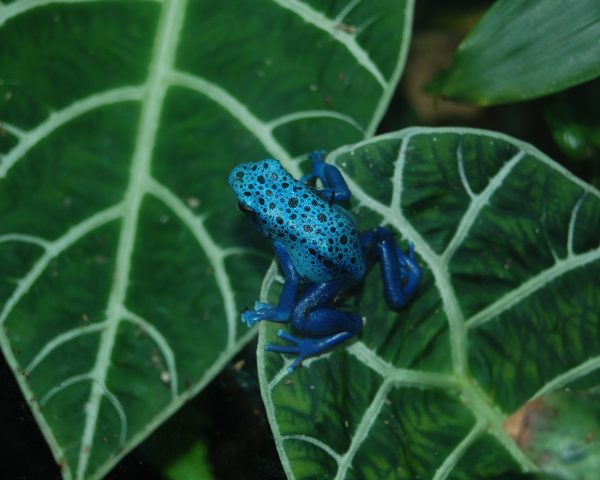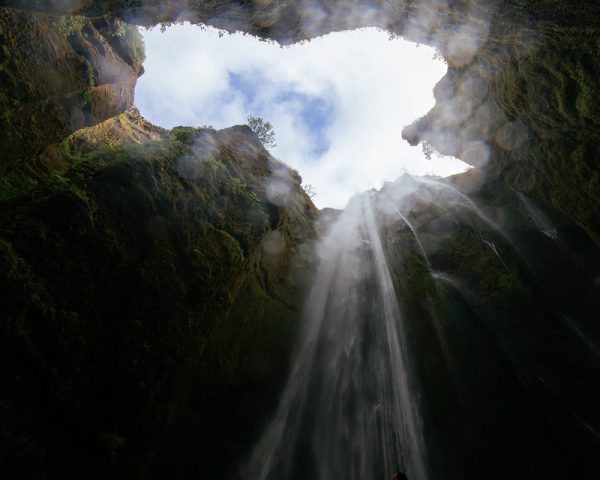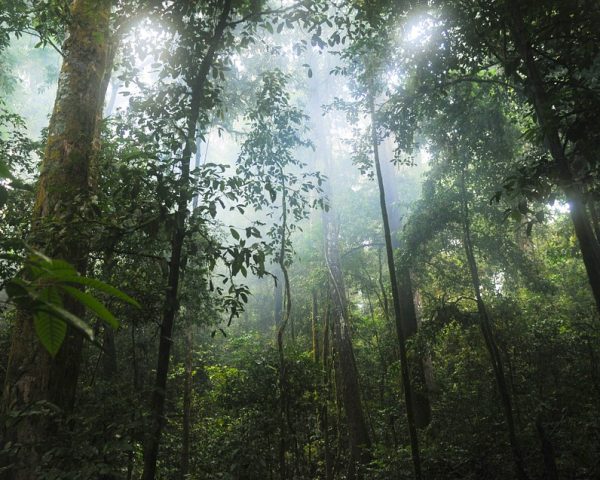“Long ago, when the ancient city of Polhmun Ão had collapsed, the surviving humans made the choice to split into separate settlements--small hmun which carried the legacy of the last great city the valley had known. It was thought to be safer, to have some distance from each other; if the resources were evenly distributed, they would not lose so many people should another great catastrophe arise. Each hmun to itself, but all in harmony.”
-Two Dark Moons
Vibrant Life and Deadly Wonders
Gãepongwei is made up of one of the largest rainforests on Shale, and is full of countless species of plants and animals. From above, the thick caps of the emergent layer are about all that is visible, but those on the forest floor can look up and see all the life bursting within. Most of the creatures of Gãepongwei live above in the bright canopy, but the dark, damp understory is full of a wide variety of broadleaf plants. Trees tend to grow taller along the enormous Ãotul River, which runs vertically up the region and provides tributaries that stretch out along the ground.
One of the land’s most prominent features would be the distinctive clusters of karst-like, quartzite mountains in the center. One of Gãepongwei’s many hmun lives atop the five-mountain range known below as the God’s Hand–though the people themselves refer to their hmun as “Ateng”, or “above”. Other human settlements can be found in and around the lower parts of other mountains, keeping themselves hidden from the region’s many predators.
The dramatic differences in the land’s elevation also lends itself to many waterfalls, tucked among the lush greenery. While the density of the rainforest slightly tapers off toward the northern beaches of the continent, Gãepongwei is still nearly impossible to navigate without a skilled guide.
Everything Must Eat
The most notorious predators of Gãepongwei would be the enormous, lizard-like sãoni. Between their six legs, their glowing throats, their sheer size, and their two sets of fearsome teeth, most residents of Shale are quite thankful that these creatures are only found in Gãepongwei, where they follow a careful migration route throughout the year. Carnivorous and opportunistic feeders, the sãoni eat just about anything with a pulse–though they have a particular affinity for the capybaras that live along the riverside. The poisonous silvertongue plant is one of their only deterrents; keeping several leaves nearby is a good way to keep back the predators in a crisis.
But don’t be fooled by size alone–sãoni aren’t the only things in the rainforest with a taste for blood. Poison frogs, vicious insects, and gigantic carnivorous plants all await uncertain prey. Above in the canopy, large birds will also scoop up smaller animals, or the occasional human child. With such an abundance of predators big and small, the Gãepongwei rainforest is a land where the camouflaged are the most likely to survive.
The Fall of an Ancient Civilization
Every hmun in Gãepongwei knows the story of the ancient civilization of Polhmun Ão and its eventual collapse. According to legend, this magnificent walled city was once an aspiring utopia, the flourishing pride of Cygmia. With every advance the people made, they became hungry for more, trying to grow until they rivalled the realm of the gods. They kept their walls high, trying to block out all that would interfere, until one day the world seemed to end around them. The sky became dark and unpredictable, blocking out the eyes of the gods–the moons Ama and Chehang. Even their combined power, Chehangma the sun, was not visible through the darkness.
The changes around them worsened–animals died, illness struck, the people perished horribly behind their walls. The unification that had once empowered them now doomed them, and the royalty were at a loss as to how they could help. Eventually, several key figures came together with the suggestion that the city split into smaller communities. Should tragedy strike once more, they would not trap themselves a second time. These villages called themselves “hmun”, honouring their ancestral Polhmun Ão.
Some hmun interpret this historical catastrophic event as the gods punishing the people of Polhmun Ão for their arrogance. Others believe the gods themselves had entered a time of crisis but humans had spent too much time focused on their own achievements to remember how to help. Either way, nearly all of the hmun are, to this day, extraordinarily dedicated to their lunar religion, determined never to lose track of the needs and desires of their gods again.
- Geography
-
Vibrant Life and Deadly Wonders
Gãepongwei is made up of one of the largest rainforests on Shale, and is full of countless species of plants and animals. From above, the thick caps of the emergent layer are about all that is visible, but those on the forest floor can look up and see all the life bursting within. Most of the creatures of Gãepongwei live above in the bright canopy, but the dark, damp understory is full of a wide variety of broadleaf plants. Trees tend to grow taller along the enormous Ãotul River, which runs vertically up the region and provides tributaries that stretch out along the ground.
One of the land’s most prominent features would be the distinctive clusters of karst-like, quartzite mountains in the center. One of Gãepongwei’s many hmun lives atop the five-mountain range known below as the God’s Hand–though the people themselves refer to their hmun as “Ateng”, or “above”. Other human settlements can be found in and around the lower parts of other mountains, keeping themselves hidden from the region’s many predators.
The dramatic differences in the land’s elevation also lends itself to many waterfalls, tucked among the lush greenery. While the density of the rainforest slightly tapers off toward the northern beaches of the continent, Gãepongwei is still nearly impossible to navigate without a skilled guide.
- Natural Predators
-
Everything Must Eat
The most notorious predators of Gãepongwei would be the enormous, lizard-like sãoni. Between their six legs, their glowing throats, their sheer size, and their two sets of fearsome teeth, most residents of Shale are quite thankful that these creatures are only found in Gãepongwei, where they follow a careful migration route throughout the year. Carnivorous and opportunistic feeders, the sãoni eat just about anything with a pulse–though they have a particular affinity for the capybaras that live along the riverside. The poisonous silvertongue plant is one of their only deterrents; keeping several leaves nearby is a good way to keep back the predators in a crisis.
But don’t be fooled by size alone–sãoni aren’t the only things in the rainforest with a taste for blood. Poison frogs, vicious insects, and gigantic carnivorous plants all await uncertain prey. Above in the canopy, large birds will also scoop up smaller animals, or the occasional human child. With such an abundance of predators big and small, the Gãepongwei rainforest is a land where the camouflaged are the most likely to survive.
- Polhmun Ão
-
The Fall of an Ancient Civilization
Every hmun in Gãepongwei knows the story of the ancient civilization of Polhmun Ão and its eventual collapse. According to legend, this magnificent walled city was once an aspiring utopia, the flourishing pride of Cygmia. With every advance the people made, they became hungry for more, trying to grow until they rivalled the realm of the gods. They kept their walls high, trying to block out all that would interfere, until one day the world seemed to end around them. The sky became dark and unpredictable, blocking out the eyes of the gods–the moons Ama and Chehang. Even their combined power, Chehangma the sun, was not visible through the darkness.
The changes around them worsened–animals died, illness struck, the people perished horribly behind their walls. The unification that had once empowered them now doomed them, and the royalty were at a loss as to how they could help. Eventually, several key figures came together with the suggestion that the city split into smaller communities. Should tragedy strike once more, they would not trap themselves a second time. These villages called themselves “hmun”, honouring their ancestral Polhmun Ão.
Some hmun interpret this historical catastrophic event as the gods punishing the people of Polhmun Ão for their arrogance. Others believe the gods themselves had entered a time of crisis but humans had spent too much time focused on their own achievements to remember how to help. Either way, nearly all of the hmun are, to this day, extraordinarily dedicated to their lunar religion, determined never to lose track of the needs and desires of their gods again.
An Intricate and Intentional Trade Network
Today, the hmun of Gãepongwei live in separate communities, each with their own varying customs and traditions. While all of these villages are descended from the ancient city of Polhmun Ão, there is a fair amount of variation in beliefs and languages from hmun to hmun. Their link to each other is through an extensive trade network, facilitated by the trade tongue of “dulpongpa”, the closest relative of the original language of Polhmun Ão. Each hmun has a dedicated group of traders, passing them the knowledge needed to survive the journeys they make each year along the forest floor. On these excursions, they are expected to exchange goods and news to neighbouring hmun. Often, they will bring along an oracle for the sake of sharing different spiritual interpretations of astrological circumstances.
While individual hmun are very self-contained, they see the others as dear cousins and will do what they can to provide aid in times of crisis. While trade disagreements between hmun have arisen over the millennia, instances of violent conflict between villages is nearly unheard of. The rainforest of Gãepongwei is incredibly unforgiving, and for the most part people spend their energy surviving their environment rather than waging war on their neighbours.
Life Beneath the Godseye
The hmun of Gãepongwei believe that the two moons are the eyes of the gods Ama and Chehang, which come together during the day to form the sun, Chehangma. Many elements of people’s daily lives are dictated based on the shape and focus of the godseye. Students of the religion know that the motion of the phases tells the story of the rise and fall of Polhmun Ão, which is closely studied so that it might not be repeated.
While there is variation in the names and interpretations of the lunar phases, all of the hmun agree that the phase someone is born under has significant impact on their life and personality. The phase of “Minhal” can be particularly contentious, as this is the time when neither Ama nor Chehang are visible in the sky, and the unfortunate children born under this phase might be cast out from their hmun altogether.
In the hmun “Ateng”, featured in Two Dark Moons, the names of the phases are as follows: Par, Go, Hiwei, Fua, Tang, Sol, Jão, Pel, Dongi, Se, Won, Nor, Chisong, Heng, Li, Ginhãe, Mi, Ker Hiun, Ãofe, Soon, Nai, Tos, Jeji, Minhal. All together, these phases make up a cycle, and four cycles make up a year. The cycles are also divided into thirds (Par-Dongi, Se-Mi, Ker-Minhal), outlining the three acts of Polhmun Ão’s story, or the three phases of one’s life journey.
Curious about your place in the cycle? Take our quiz!
Cosmically Ordained Identity
While marriage and family customs vary across the hmun of Gãepongwei, there are some consistencies that are shared across the rainforest. Gender is assigned based on the lunar phase someone is born under, though there might be disagreements as to how the phases are gendered between communities. It is generally agreed that there are masculine, feminine, and neutral genders in each community, though some hmun might split neutrality into multiple separate categories. In each hmun, gender is identified based on the phase associated with their name; for example, if someone was introduced as “Jinho Tang”, you would know he was a man based on the “Tang”. In the trade tongue of dulpongpa, personal pronouns are also gendered to minimize inter-hmunal confusion; the introduction of “I am Jinho Tang” would identify masculinity through the type of “I” used.
In the hmun Ateng in particular, forming a family is often done with heavy consideration of how the community as a whole will be impacted. The community elders and matchmaking oracles will often make relationship suggestions, guiding people together based on their phasal compatibility. It is rare, but not unheard of, for people to be outright denied marriage to an unapproved partner if they are not considered astrologically compatible. More likely they will be encouraged to take a third, balancing partner or have an auspiciously-timed baby.
Child-bearing is often regulated in a similar way–because procreating will impact the astrological balance of the entire community, it is very rare that babies will be had haphazardly. Most hmun have their own methods of birth control, and use it carefully to plan babies for a time that will create both a balanced family and hmun. Should a couple be of the same sex, they can arrange for a compatible “damwei”–either a sperm donor or surrogate–to help them make a child. A damwei is not expected to serve as a parental figure to the children they create, but neither are they discouraged from it should they show capability and an active interest.
- The Network
-
An Intricate and Intentional Trade Network
Today, the hmun of Gãepongwei live in separate communities, each with their own varying customs and traditions. While all of these villages are descended from the ancient city of Polhmun Ão, there is a fair amount of variation in beliefs and languages from hmun to hmun. Their link to each other is through an extensive trade network, facilitated by the trade tongue of “dulpongpa”, the closest relative of the original language of Polhmun Ão. Each hmun has a dedicated group of traders, passing them the knowledge needed to survive the journeys they make each year along the forest floor. On these excursions, they are expected to exchange goods and news to neighbouring hmun. Often, they will bring along an oracle for the sake of sharing different spiritual interpretations of astrological circumstances.
While individual hmun are very self-contained, they see the others as dear cousins and will do what they can to provide aid in times of crisis. While trade disagreements between hmun have arisen over the millennia, instances of violent conflict between villages is nearly unheard of. The rainforest of Gãepongwei is incredibly unforgiving, and for the most part people spend their energy surviving their environment rather than waging war on their neighbours.
- Lunar Religion
-
Life Beneath the Godseye
The hmun of Gãepongwei believe that the two moons are the eyes of the gods Ama and Chehang, which come together during the day to form the sun, Chehangma. Many elements of people’s daily lives are dictated based on the shape and focus of the godseye. Students of the religion know that the motion of the phases tells the story of the rise and fall of Polhmun Ão, which is closely studied so that it might not be repeated.
While there is variation in the names and interpretations of the lunar phases, all of the hmun agree that the phase someone is born under has significant impact on their life and personality. The phase of “Minhal” can be particularly contentious, as this is the time when neither Ama nor Chehang are visible in the sky, and the unfortunate children born under this phase might be cast out from their hmun altogether.
In the hmun “Ateng”, featured in Two Dark Moons, the names of the phases are as follows: Par, Go, Hiwei, Fua, Tang, Sol, Jão, Pel, Dongi, Se, Won, Nor, Chisong, Heng, Li, Ginhãe, Mi, Ker Hiun, Ãofe, Soon, Nai, Tos, Jeji, Minhal. All together, these phases make up a cycle, and four cycles make up a year. The cycles are also divided into thirds (Par-Dongi, Se-Mi, Ker-Minhal), outlining the three acts of Polhmun Ão’s story, or the three phases of one’s life journey.
Curious about your place in the cycle? Take our quiz!
- The Body and the Family
-
Cosmically Ordained Identity
While marriage and family customs vary across the hmun of Gãepongwei, there are some consistencies that are shared across the rainforest. Gender is assigned based on the lunar phase someone is born under, though there might be disagreements as to how the phases are gendered between communities. It is generally agreed that there are masculine, feminine, and neutral genders in each community, though some hmun might split neutrality into multiple separate categories. In each hmun, gender is identified based on the phase associated with their name; for example, if someone was introduced as “Jinho Tang”, you would know he was a man based on the “Tang”. In the trade tongue of dulpongpa, personal pronouns are also gendered to minimize inter-hmunal confusion; the introduction of “I am Jinho Tang” would identify masculinity through the type of “I” used.
In the hmun Ateng in particular, forming a family is often done with heavy consideration of how the community as a whole will be impacted. The community elders and matchmaking oracles will often make relationship suggestions, guiding people together based on their phasal compatibility. It is rare, but not unheard of, for people to be outright denied marriage to an unapproved partner if they are not considered astrologically compatible. More likely they will be encouraged to take a third, balancing partner or have an auspiciously-timed baby.
Child-bearing is often regulated in a similar way–because procreating will impact the astrological balance of the entire community, it is very rare that babies will be had haphazardly. Most hmun have their own methods of birth control, and use it carefully to plan babies for a time that will create both a balanced family and hmun. Should a couple be of the same sex, they can arrange for a compatible “damwei”–either a sperm donor or surrogate–to help them make a child. A damwei is not expected to serve as a parental figure to the children they create, but neither are they discouraged from it should they show capability and an active interest.

